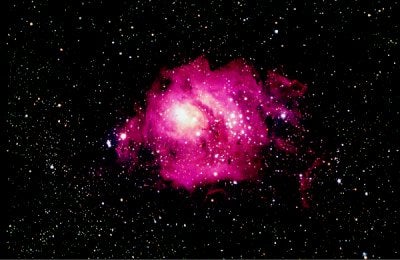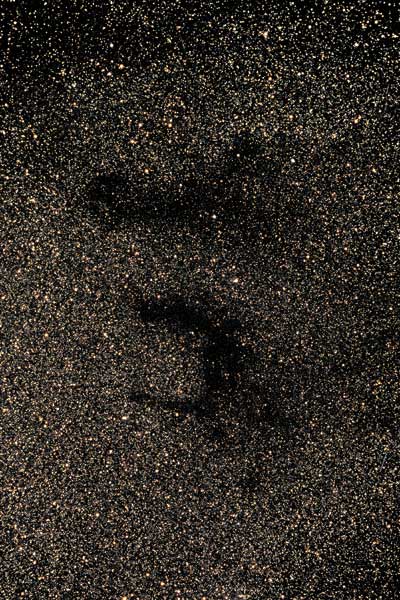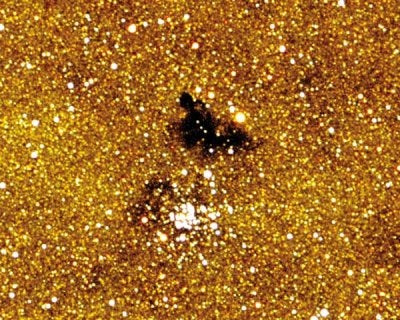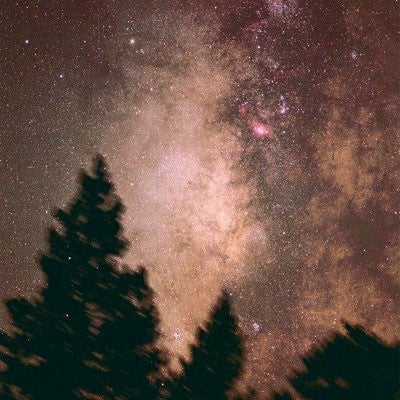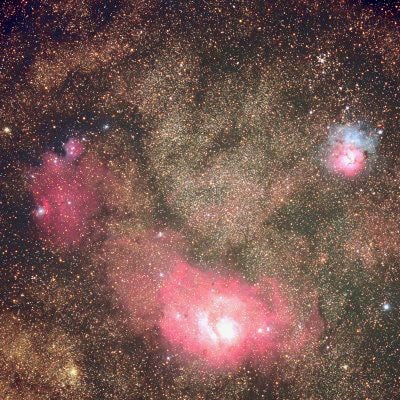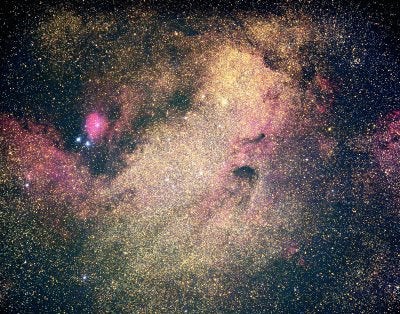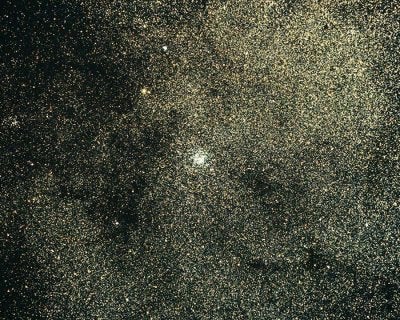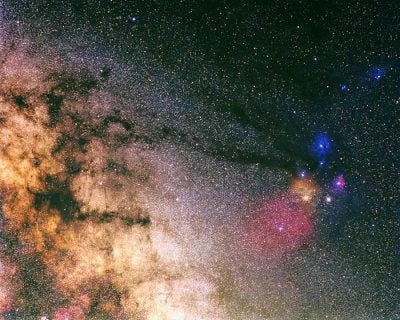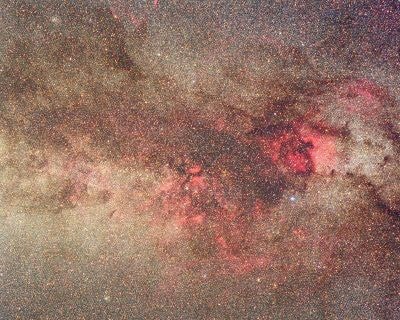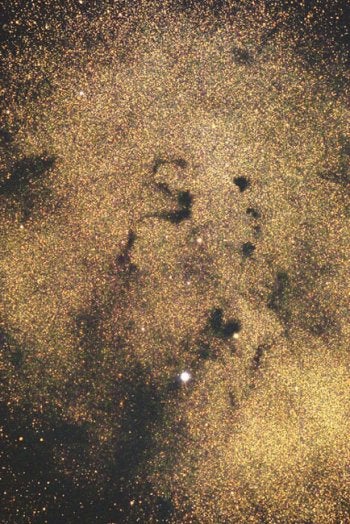The Lagoon Nebula
The Lagoon Nebula, M8, as photographed through a 7-inch refractor, gets its name from the dark band of dust separating its two bright sections.
The Lagoon Nebula, M8, as photographed through a 7-inch refractor, gets its name from the dark band of dust separating its two bright sections.
Aquila and dark nebulae
The constellation Aquila holds a pair of dark nebulae: B142 and B143.
The constellation Aquila holds a pair of dark nebulae: B142 and B143.
B86 Nebula
A magnified view of B86 shows why it is so easy to see compared to its background.
A magnified view of B86 shows why it is so easy to see compared to its background.
The red Lagoon Nebula (M8) lies just above and to the right of the center of this 5-minute exposure. Open clusters M6 and M7 lie on either side of the middle pine tree. The center of our galaxy is believed to lie behind the dark area just to the right of the bright Large Sagittarius Star Cloud near the center of the image.
Sagittarius Milky Way
The red Lagoon Nebula (M8) lies just above and to the right of the center of this 5-minute exposure. Open clusters M6 and M7 lie on either side of the middle pine tree. The center of our galaxy is believed to lie behind the dark area just to the right of the bright Large Sagittarius Star Cloud near the center of the image.
The red Lagoon Nebula (M8) lies just above and to the right of the center of this 5-minute exposure. Open clusters M6 and M7 lie on either side of the middle pine tree. The center of our galaxy is believed to lie behind the dark area just to the right of the bright Large Sagittarius Star Cloud near the center of the image.
The red Lagoon Nebula (M8) lies at the bottom center of this 50-minute exposure. In the lower left of the image, a globular cluster called NGC 6544 is partially obscured by star clouds. Above it, along the left (east) side of the image is the NGC 6559 nebula complex, which includes reflection, emission, and dark nebulae. NGC 6559 is the brightest area in the left-center part of the region. In the upper right of the image is the small open cluster M21. Below (to the south of) M21 is the Trifid Nebula (M20), which consists of a blue reflection nebula and a red emission nebula.
M8, M20, and NGC 6559
The red Lagoon Nebula (M8) lies at the bottom center of this 50-minute exposure. In the lower left of the image, a globular cluster called NGC 6544 is partially obscured by star clouds. Above it, along the left (east) side of the image is the NGC 6559 nebula complex, which includes reflection, emission, and dark nebulae. NGC 6559 is the brightest area in the left-center part of the region. In the upper right of the image is the small open cluster M21. Below (to the south of) M21 is the Trifid Nebula (M20), which consists of a blue reflection nebula and a red emission nebula.
The red Lagoon Nebula (M8) lies at the bottom center of this 50-minute exposure. In the lower left of the image, a globular cluster called NGC 6544 is partially obscured by star clouds. Above it, along the left (east) side of the image is the NGC 6559 nebula complex, which includes reflection, emission, and dark nebulae. NGC 6559 is the brightest area in the left-center part of the region. In the upper right of the image is the small open cluster M21. Below (to the south of) M21 is the Trifid Nebula (M20), which consists of a blue reflection nebula and a red emission nebula.
Two dark nebulae called B93 and B92 lie in the northern (right) portion of the Small Sagittarius Star Cloud. To the south (left) of the star cloud is the red emission nebula IC 1283-1284 and the two smaller, blue reflection nebulae NGC 6589 and NGC 6590.
Small Sagittarius star cloud
Two dark nebulae called B93 and B92 lie in the northern (right) portion of the Small Sagittarius Star Cloud. To the south (left) of the star cloud is the red emission nebula IC 1283-1284 and the two smaller, blue reflection nebulae NGC 6589 and NGC 6590.
Two dark nebulae called B93 and B92 lie in the northern (right) portion of the Small Sagittarius Star Cloud. To the south (left) of the star cloud is the red emission nebula IC 1283-1284 and the two smaller, blue reflection nebulae NGC 6589 and NGC 6590.
This image of the M11 (“Wild Duck”) cluster is a composite of two 35-minute exposures. Below and to the right of M11 is the small dark nebula B108. To the left and above is the large dark nebula B320. The gold-colored stars above and to the right of M11 is the southern part of the Scutum Star Cloud called “The Gem of the Milky Way” by E.E. Barnard.
Michael Stecker
M11
This image of the M11 (“Wild Duck”) cluster is a composite of two 35-minute exposures. Below and to the right of M11 is the small dark nebula B108. To the left and above is the large dark nebula B320. The gold-colored stars above and to the right of M11 is the southern part of the Scutum Star Cloud called “The Gem of the Milky Way” by E.E. Barnard.
This image of the M11 (“Wild Duck”) cluster is a composite of two 35-minute exposures. Below and to the right of M11 is the small dark nebula B108. To the left and above is the large dark nebula B320. The gold-colored stars above and to the right of M11 is the southern part of the Scutum Star Cloud called “The Gem of the Milky Way” by E.E. Barnard.
The bright yellow star on the right is Antares, a red supergiant surrounded by a yellow-orange nebula. Above it (north) is Rho Ophiuchus, which is encompassed by a blue nebula. Just below Antares is the large diffuse red nebula RCW 129 and to its upper right is the small red-blue nebula Sharpless 9. Between these two nebulae is the globular cluster M4. Long dark nebulae B44 and B45 extend to the left where they reach a myriad of dark nebulae in the bright Ophiuchus Milky Way. The most prominent of these dark nebulae is called the Pipe Nebula.
Ophiucus Star Clouds, Pipe Nebula, and Antares
The bright yellow star on the right is Antares, a red supergiant surrounded by a yellow-orange nebula. Above it (north) is Rho Ophiuchus, which is encompassed by a blue nebula. Just below Antares is the large diffuse red nebula RCW 129 and to its upper right is the small red-blue nebula Sharpless 9. Between these two nebulae is the globular cluster M4. Long dark nebulae B44 and B45 extend to the left where they reach a myriad of dark nebulae in the bright Ophiuchus Milky Way. The most prominent of these dark nebulae is called the Pipe Nebula.
The bright yellow star on the right is Antares, a red supergiant surrounded by a yellow-orange nebula. Above it (north) is Rho Ophiuchus, which is encompassed by a blue nebula. Just below Antares is the large diffuse red nebula RCW 129 and to its upper right is the small red-blue nebula Sharpless 9. Between these two nebulae is the globular cluster M4. Long dark nebulae B44 and B45 extend to the left where they reach a myriad of dark nebulae in the bright Ophiuchus Milky Way. The most prominent of these dark nebulae is called the Pipe Nebula.
Cygnus from right to left (north to south) starts with the emission nebula
Sharpless 119 in the upper right. Next is the bright star Deneb, North American Nebula, and Pelican Nebula. Just below center is the star Gamma Cygnus and its emission nebula IC 1318. On the left is the dark nebula Barnard 144 or LDN 857 (called “Fish on the Platter” by astronomer Bart Bok) which is buried in the rich Cygnus star cloud.
Sharpless 119 in the upper right. Next is the bright star Deneb, North American Nebula, and Pelican Nebula. Just below center is the star Gamma Cygnus and its emission nebula IC 1318. On the left is the dark nebula Barnard 144 or LDN 857 (called “Fish on the Platter” by astronomer Bart Bok) which is buried in the rich Cygnus star cloud.
Northern Cygnus star clouds
Cygnus from right to left (north to south) starts with the emission nebula Sharpless 119 in the upper right. Next is the bright star Deneb, North American Nebula, and Pelican Nebula. Just below center is the star Gamma Cygnus and its emission nebula IC 1318. On the left is the dark nebula Barnard 144 or LDN 857 (called “Fish on the Platter” by astronomer Bart Bok) which is buried in the rich Cygnus star cloud.
Cygnus from right to left (north to south) starts with the emission nebula Sharpless 119 in the upper right. Next is the bright star Deneb, North American Nebula, and Pelican Nebula. Just below center is the star Gamma Cygnus and its emission nebula IC 1318. On the left is the dark nebula Barnard 144 or LDN 857 (called “Fish on the Platter” by astronomer Bart Bok) which is buried in the rich Cygnus star cloud.
This composite of two 50-minute exposures shows the S-shaped nebula in Ophiucus called B72. To the right of it are three smaller dark nebulae B68, B69, and B70. To the upper right of the brightest star in the image is the dark nebula B74. At the lower left corner of the image is part of B78 (the bowl of the Pipe Nebula).
S-shaped nebula
This composite of two 50-minute exposures shows the S-shaped nebula in Ophiucus called B72. To the right of it are three smaller dark nebulae B68, B69, and B70. To the upper right of the brightest star in the image is the dark nebula B74. At the lower left corner of the image is part of B78 (the bowl of the Pipe Nebula).
This composite of two 50-minute exposures shows the S-shaped nebula in Ophiucus called B72. To the right of it are three smaller dark nebulae B68, B69, and B70. To the upper right of the brightest star in the image is the dark nebula B74. At the lower left corner of the image is part of B78 (the bowl of the Pipe Nebula).

